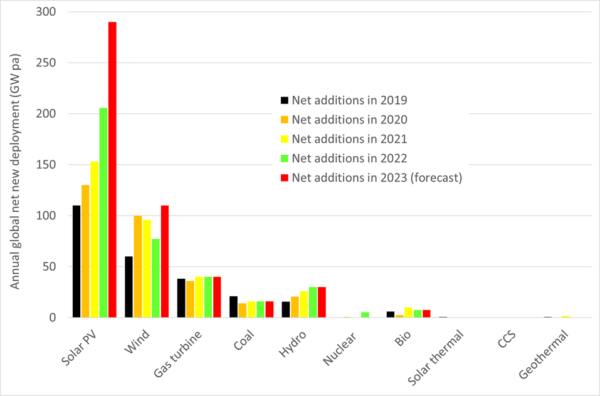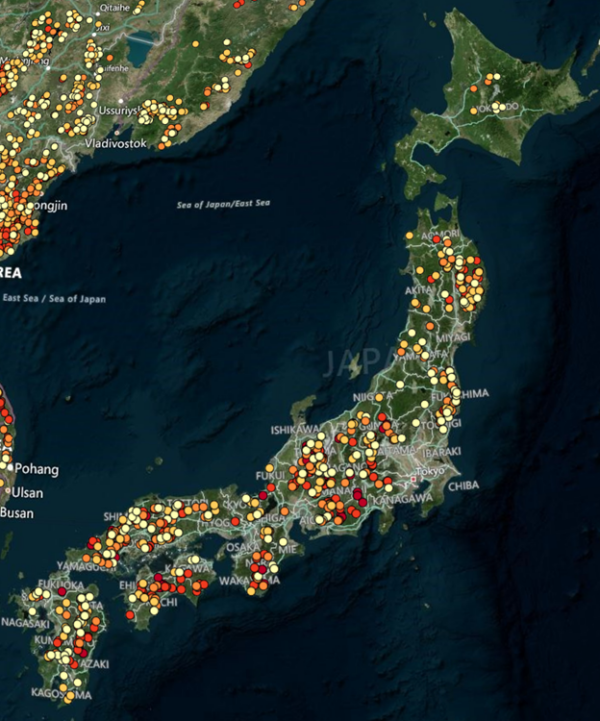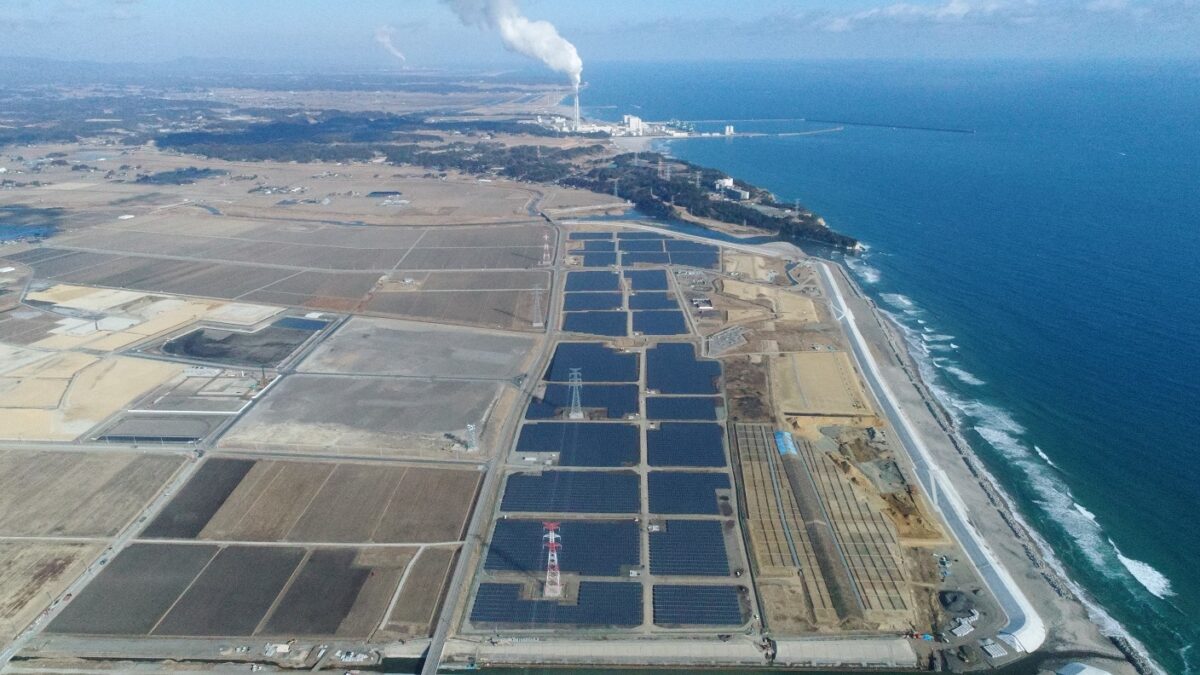From pv magazine Global
By far the fastest energy change in history is underway. Solar and wind generators comprise three quarters of global electricity generation capacity additions (Figure 1). This is compelling market-based evidence that solar and wind are cheaper than fossil fuel generation. Solar has been the leading technology since 2016 and may reach 60% of new generation capacity in 2023.

Image: International Solar Energy Society
Image: International Solar Energy Society
Energy in Japan
Japan could produce all of its electricity from wind and solar for $86/110 MWh, which is competitive with current market prices. This includes the cost of transmission and storage needed to balance 100% renewable electricity. Japan could set an example for the world.
Most Japanese emissions could be eliminated well before 2050 through the generation of zero-emission electricity from solar and wind, coupled with the electrification of transport, heating and industry. To achieve this, Japan’s current electricity consumption will need to double.
Japan has enormous and high quality offshore wind resources. Japan could generate about 50 times more electricity than current consumption using offshore wind sourced from its exclusive economic zone. This means that Japan can be very choosy about where it locates offshore wind farms, to harvest the highest wind speeds and minimize cost and environmental impact.
Japan’s solar potential is also large. It has the potential to produce four times its current consumption from solar panels located on rooftops, floating on inland water bodies and deployed in conjunction with agriculture. Japan’s population of 125 million is forecast to decline by 18% to 102 million by 2050, which could free up 18%, or 8000 km2 of its current agricultural land. This land alone would be enough to provide all of Japan’s energy requirements from solar energy.
Large-scale electrical energy storage to support solar and wind is a solved problem in the form of batteries (for storage of seconds to hours) and Pumped Hydro Energy Storage (for overnight and longer periods). ANU’s global pumped hydro atlas shows 2,400 good sites in Japan with a combined storage potential of 53 TWh. Only a few dozen sites are required to support a 100% renewable energy system.

Image: International Solar Energy Society
Japan is lagging behind
Japan used to be a global renewable energy leader. Sadly, Japan is now lagging well behind pathfinder countries in terms of annual per capita deployment of new renewable energy. Netherlands, Sweden, Australia and Finland are installing solar and wind five times faster (per capita) than Japan, and China, Spain Germany and the USA are installing solar and wind twice as fast.
The Japanese government’s Clean Energy Strategy Interim Report lacks clear recognition of the crucial role of solar and wind in global decarbonization and, instead, it promotes nuclear energy, imported hydrogen and carbon capture and storage (CCS). This is unlikely to be a good choice.
Global nuclear capacity has been static at about 400 GW since 2010. In 2022 the solar deployment rate was 200 Gigawatts, and it is rapidly growing every year. This is compelling evidence that nuclear is uncompetitive with solar.
Carbon capture and storage (CCS) has achieved zero commercial success in the electricity industry. Solar PV and wind already have a compelling economic advantage over fossil fuel generation without CCS, as shown by their dominance of new power station deployment. Electricity from fossil-fuelled power stations will become even less competitive if they are equipped with CCS because of large capital cost and the parasitic energy costs of CCS.
Importation of clean hydrogen for energy production (for example from Australia) is expensive because about three-quarters of the energy is lost in compression, shipping, storage and conversion which triples the effective energy cost. It’s cheaper for Japan to produce its own electricity from wind and solar than to import clean hydrogen.
About 10 million electric cars were sold in 2023, compared with 20,000 hydrogen-powered vehicles. Japan’s export car industry is at risk due to a lack of focus on developing competitive models for the booming electric vehicle market.
Future energy
Pathfinder countries in northern Europe and Australia are showing that it is straightforward to largely decarbonize the electricity system via solar and wind. Japan will need to step up its pace of deployment of wind and solar tenfold to decarbonize by mid-century.
With the right policies, Japan can look forward to a sustainable future in which it no longer imports oil, coal, gas or uranium. Unlimited energy can come from rooftop solar panels, solar farms and offshore wind turbines. This provides a high degree of energy independence and resilience in the face of a pandemic, war or trade disruption.
Key elements needed for industrial precursor chemicals, ammonia, plastics, synthetic jet fuel and many other materials are hydrogen, carbon, oxygen, sodium, chlorine and nitrogen. These are available everywhere from seawater and air. Japan’s chemical industry can be substantially self-sufficient, with driving energy coming from indigenous wind and solar.
Most buildings can have their own solar panels, energy storage, electric space and water heating, and electric vehicles. This eliminates greenhouse emissions, car exhausts, smog, oil spills, coal plant exhausts, ash dumps, nuclear accidents, and nuclear waste disposal. Japan can lock in cheap, clean, and highly reliable perpetual energy.
The old certainties of fossils are rapidly fading. The world is moving to solar and wind at a similar speed to digital photography’s displacement of film cameras. Hopefully, Japan does not have its very own Kodak moment.
Authors: Prof. Andrew Blakers (ANU) and Prof. Ricardo Rüther (UFSC)
Andrew.blakers@anu.edu.au and rruther@gmail.com
ISES, the International Solar Energy Society is a UN-accredited membership NGO that was founded in 1954. It is working toward a world with 100% renewable energy for all, used efficiently and wisely.
The views and opinions expressed in this article are the author’s own, and do not necessarily reflect those held by pv magazine.
This content is protected by copyright and may not be reused. If you want to cooperate with us and would like to reuse some of our content, please contact: editors@pv-magazine.com.








By submitting this form you agree to pv magazine using your data for the purposes of publishing your comment.
Your personal data will only be disclosed or otherwise transmitted to third parties for the purposes of spam filtering or if this is necessary for technical maintenance of the website. Any other transfer to third parties will not take place unless this is justified on the basis of applicable data protection regulations or if pv magazine is legally obliged to do so.
You may revoke this consent at any time with effect for the future, in which case your personal data will be deleted immediately. Otherwise, your data will be deleted if pv magazine has processed your request or the purpose of data storage is fulfilled.
Further information on data privacy can be found in our Data Protection Policy.